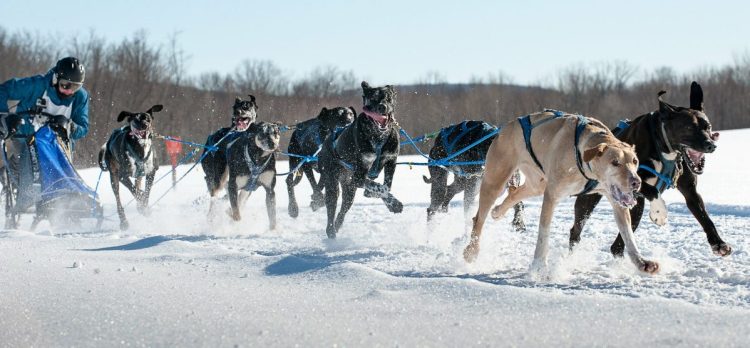FARMINGTON — Competitive dog sled racing in Maine isn’t what it used to be.
Nineteen years ago, human-canine teams could enter upwards of five competitions across the state. Now, while there are still a handful of dryland offerings, the Maine State Sled Dog Race is the only snow-based dog racing contest left. This weekend, 52 competitors from New England and Canada registered to participate in the 2019 event, held at the Sandy River Farm in Farmington.
“We can only put it on if the conditions are right, if we have enough snow, ’cause this place is full of cornstalks,” said Joy Turner of Jay, who calls herself an ambassador of the Down East Sled Dog Club that hosts the race. “One year it was like, ‘We can’t do this.’ There were just too many to pluck.”
A midweek winter storm ensured that history wouldn’t repeat itself this year, coating the ground with 6 inches of fresh snow before the two-day affair. Throughout the weekend, the Franklin County 4-H Beef Boosters Club was on hand to serve up burgers, hot dogs and other snacks by the start and finish lines.
While they may be few and far between, Maine dog-sledding competitions are still a lot of fun.
Over the course of the weekend, each racer competes twice – once Saturday and once Sunday. Officials add the times of each run together to create a composite score that determines final rankings. Racers must use the same dogs each day.
Amy Craves took home gold in the one- to two-dog skijor category – where dogs pull a person on skis – with a combined time of 36:39.0 on a four-mile trail. Jean-Rene Saucier claimed the first-place slot for the four-dog sled sprint, also on a four-mile track, with a time of 32:30.2. Nova Clifford won in the six-dog rig category, with a time of 43:44.3, and Jocelyn Bradbury emerged victorious in the eight-dog rig, clocking in at 58:05.2.
The six-dog class followed a 6-mile course, while the eight-dog class completed an 8-mile course. Full scores can be found online through Back 40 Events.
This weekend marked the first use of tracking chips to calculate scores in the competition’s history. Turner, 61, had been the event’s official timer since the club’s founding in Oxford about two decades ago.
“It feels strange to be out here with nothing to do,” she said. “I’m jobless.”
While she might not have manned the clocks this year, Turner kept busy in the lead-up by securing sponsorships from 21 local businesses ranging from Franklin Savings Bank to The Corner Store in Chesterville. Her husband, Mark, 52, prepared the 2-, 4-, 6- and 8-mile race trails this weekend. But the couple credits their son Jake, 32, with spurring their interest in the sport years ago.
“Jake’s the one who got us into this,” Joy Turner said.
“When he was 9, he saw the Iditarod on TV and wanted to do that,” she said, referring to the famous Alaskan long-distance race. “So we ended up getting three old dogs and a really old, handmade sled. We went to East Corinth, they had a race there, and he came in first place in the three-dog junior.”
At one point, after his three siblings got involved, the Turner family owned about 30 dogs, Joy estimated.
Now, Jake’s own children – Rylee, 10, Ava, 7, and Aspen, 4 – compete in dog-sledding. Rylee Turner placed first in the 4-mile, three-dog junior race this weekend, finishing with a combined time of 51:38.1.
It’s not just the Turners who have harbored a lifelong passion for dog sledding and skijoring, though. Sara Vanderwood, 47, said she became interested as a young girl.
“I’ve been involved for 43 years,” said the Oxford resident. “I got my first dog for my fifth birthday and got started not long after that.”
This weekend, Vanderwood placed fourth in the four-dog class with her German short-haired pointer and Alaskan husky mixes Koko, 6, and litter mates Coe, Rask and Cruz, 2. Vanderwood and her husband, Marc, helped get skijoring “institutionalized at all of the New England races back in the mid-’90s” she said, after the prodding of Vassalboro teammate Jay Nutting, 42. “It’s been a competitive class since.”
When it comes to breeds, Vanderwood said pointers usually fare best, often placing before Alaskan husky teams and Siberian husky teams.
“(Pointers) don’t have the same preservation mechanism that your Nordic breed dogs do, so they go really hard start to finish, where dogs that have been bred for thousands of years to run always keep a little something in the bank,” Vanderwood said.
Vanderwood said she has raced with dogs as old as 10, but 9-month-old puppy Toko led Nutting to a third-place finish in the skijor category this weekend.
Vanderwood explained that in dogsledding, the dogs positioned in front provide power while the ones closest to the sled, called wheelers, control the direction of the sled.
With regard to choosing which dogs go where, she said, “Leaders are born, not made.”
In this weekend’s races, Vanderwood observed one of her wheelers, Cruz, wanting to run up front.
“Maybe next year,” she said.
Send questions/comments to the editors.




Comments are no longer available on this story